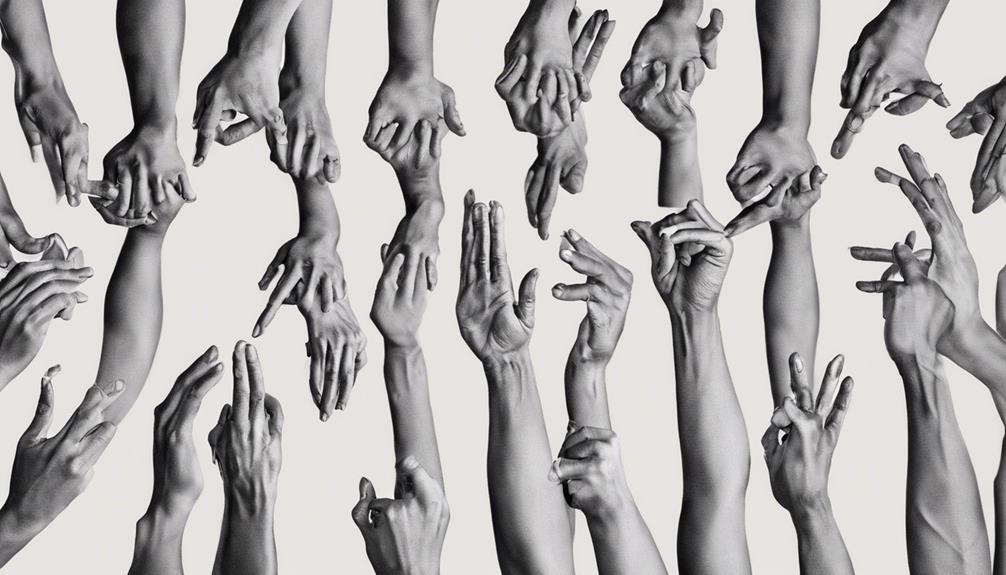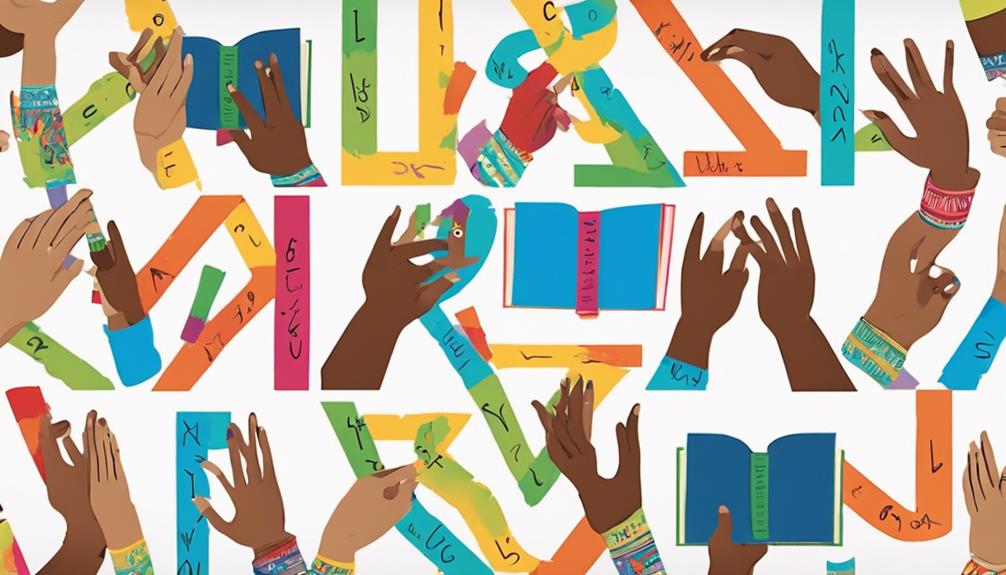In American Sign Language, the sign for ‘banana’ may appear simple, but its meaning extends beyond just representing fruit.
By learning how to sign 'banana' in ASL, we can uncover the intricate nuances of nonverbal communication and expand our vocabulary in this visual language.
Understanding the intricacies of signing common items like 'banana' not only enriches our linguistic capabilities but also opens doors to a world of connection and expression that transcends words.
Key Takeaways
- Proper handshape is crucial for accurate signing of 'Banana'.
- Regular practice aids in mastering the sign for 'Banana'.
- Differentiate signs accurately to convey 'Banana' correctly.
- Understanding the cultural influences on signs enhances signing 'Banana'.
Benefits of Learning ASL Signs
Learning ASL signs enhances communication skills and fosters deeper connections with the deaf and hard of hearing community. By acquiring ASL signs, we not only bridge communication gaps but also cultivate meaningful relationships within the deaf community. This form of communication goes beyond words; it embodies respect, understanding, and inclusivity.
Moreover, mastering ASL signs can lead to cognitive growth and improved language abilities for both children and adults. It stimulates the brain in unique ways, enhancing overall cognitive development. Additionally, the knowledge of ASL signs opens doors to various opportunities in fields related to the deaf community, offering fulfilling avenues for employment and volunteer work.
Origins of ASL Signs

The intricate origins of ASL signs reveal a tapestry woven with cultural influences and everyday experiences, shaping a dynamic language that reflects the Deaf community's rich history.
ASL signs have evolved over time, influenced by factors such as cultural expressions and regional variations.
Many ASL signs find their roots in everyday actions or objects; for instance, the sign for 'banana' mimics the action of peeling a banana.
The development of ASL signs is an ongoing process, with signs being created and modified based on the needs and experiences of the Deaf community.
ASL signs can also be influenced by iconicity, where the sign itself resembles the concept it represents, as observed in signs like 'banana'.
Understanding the origins of ASL signs provides valuable insights into the rich linguistic and cultural history of sign languages. This knowledge not only enhances communication but also fosters a deeper appreciation for the diverse influences that have contributed to the vibrant tapestry of ASL.
Importance of Proper Handshapes
Exploring the intricate handshapes of American Sign Language unveils the fundamental role they play in ensuring effective communication. In ASL, using the correct handshape is crucial for clear and accurate signing. Handshapes serve as the building blocks of the language, akin to the alphabet, with each shape representing a specific letter or concept.
By mastering proper handshapes, signers can distinguish between signs that may appear similar but carry distinct meanings, preventing misunderstandings. These handshapes are essential in forming signs accurately and conveying messages with precision. Learning and practicing the correct handshapes is fundamental for anyone looking to become proficient in ASL communication.
Just as pronunciation is vital in spoken languages, handshapes are the cornerstone of sign language, laying the foundation for effective interaction and understanding within the deaf community. Mastering these handshapes is a valuable skill that enhances communication and fosters inclusivity.
Common Mistakes to Avoid

Let's steer clear of common mistakes in signing 'banana' by honing in on specific handshapes and movements for accurate communication. Here are some key points to remember:
- Distinguish between signs: Ensure you differentiate the sign for 'banana' from other fruits like 'apple' or 'orange' by focusing on the unique gestures for each.
- Handshape and movement: Be mindful of the specific handshape and movement used in signing 'banana' to convey the message clearly and accurately.
- Take your time: Avoid rushing through the sign; take your time to form the sign properly, enhancing communication effectiveness.
- Practice and differentiate: Regular practice helps in distinguishing between similar signs, reducing the chances of misunderstandings when signing 'banana' in ASL.
Practice and Resources for Improvement
To enhance your signing skills for 'banana' in American Sign Language, incorporating regular practice and utilizing various resources is essential. Consistent practice and repetition play a vital role in mastering the sign for 'banana' and other signs in ASL. Online resources such as videos and tutorials can be beneficial for improving your sign language skills. Additionally, seeking out local sign language classes or workshops provides opportunities to practice signing with others, enhancing your proficiency and fluency. Joining online communities or forums dedicated to sign language can also offer valuable feedback and tips for improvement. By combining these practices and resources, you can strengthen your understanding and execution of the sign for 'banana' in ASL.
| Practice Tips | Resource Recommendations |
|---|---|
| Form a curved hand gesture | Utilize online videos |
| Bring hand towards mouth | Attend sign language classes |
| Consistent repetition | Join sign language forums |
Frequently Asked Questions
What Is the American Sign Language Sign for Banana?
The American Sign Language sign for banana involves mimicking the act of peeling a banana with your index finger. Move your hand towards your mouth as if you're eating a banana. It's a combination of visual and movement cues to represent the fruit.
Learning this sign can help in communicating food preferences effectively. Practice signing 'banana' in ASL to enhance vocabulary and communication skills.
How Do You Sign Easy in American Sign Language?
Sure!
To sign 'easy' in American Sign Language, we use a flat palm facing up with our dominant hand.
Then, with our non-dominant hand, we trace a simple line on the dominant hand's palm using the index finger.
This gesture conveys the idea of simplicity or ease.
It's a handy sign to incorporate into ASL conversations for expressing straightforward concepts.
Practicing in front of a mirror helps ensure clear and accurate hand movements.
How Do You Sign ASL for Beginners?
Sure, when starting with ASL for beginners, we suggest focusing on learning common signs that form a solid foundation. Begin by practicing daily to build vocabulary and communication skills.
Use resources like videos and guides to improve understanding. Remember, consistency is key in mastering ASL.
Start with basic signs like 'banana' to get comfortable with the language. Sign regularly to reinforce learning and progress steadily in your ASL journey.
How Do You Say I'm Learning to Sign in Asl?
We're exploring American Sign Language and its phrases. To say 'I'm learning to sign' in ASL, we sign 'I LEARN SIGN.'
This involves pointing to oneself for 'I,' making repeated movements towards the head for 'LEARN,' and a single motion near the chin for 'SIGN.'
Practicing this phrase enhances skills and showcases our journey in learning sign language.
ASL learning fosters connections and enables new forms of expression.
Can I Use American Sign Language to Sign Other Emotions and Feelings?
Yes, you can use American Sign Language to express a wide range of emotions and feelings. For example, you can learn how to sign hunger by using specific hand movements and facial expressions. ASL is a visual language that allows individuals to communicate their emotions effectively through gestures and signs.
Conclusion
Let's peel away barriers and dive into the vibrant world of American Sign Language together. Like a ripe banana, mastering ASL signs adds flavor and depth to our communication skills.
Let's continue to practice, learn, and grow, one sign at a time. Let's embrace the beauty of sign language and nourish our connections with others.
Let's sign 'banana' and savor the sweet taste of effective communication. Let's keep signing on!











